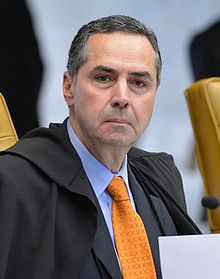| President of the Supreme Federal Court | |
|---|---|
| Supreme Federal Court | |
| Style | Mr. President (informal) Your Excellency (within court) The Most Excellent Mr. President (formal) |
| Status | Chief justice |
| Member of | Federal judiciary National Council of Justice |
| Seat | Supreme Federal Court Palace, Brasília, Federal District |
| Nominator | Members of the Supreme Court |
| Term length | Two years not renewable |
| Constituting instrument | Constitution of Brazil |
| Formation | 8 January 1829 |
| First holder | José Albano Fragoso (Supreme Court of Justice) Freitas Henriques (Supreme Federal Court) |
| Succession | Fourth |
| Salary | $39,293 BRL |
| Website | stf.jus.br |
The President of the Supreme Federal Court is the highest-ranking officer of the Brazilian judiciary branch. The holder is also president of the National Council of Justice (CNJ).[1] Among their responsibilities are representing both the Court and the council before other branches of government and authorities, presiding over plenary sessions of both institutions, enforcing the bylaws of the Court and Council, deciding points of order in their respective sessions, making decisions on injunctions during recess or vacation, and swearing in justices of the Supreme Court and councillors of the CNJ.[2][3]
The President and Vice President of the Supreme Court are elected by the other justices in a secret ballot, with a minimum quorum of eight justices, in a two-round system for a two-year term, with re-election for a new term prohibited.[2] Usually, the justices vote for the most senior justice who has not yet served as president, and they vote for the second most senior justice in the same situation as vice president. The tradition, present during most of the country's republican history, is for the Vice President to be elected by their peers to assume the presidency after the end of their term. The self-governance and self-determination of the Supreme Federal Court regarding the choice of its president did not exist in two historical periods. During the monarchy, the Emperor of Brazil appointed the President of the Supreme Court of Justice for a renewable three-year term.[4] Under the Constitution of 1937, the President of Brazil appointed the President of the Court from among the justices of the current composition for an indefinite term.[5][6]
The President of the Supreme Federal Court is fourth in the Brazilian presidential line of succession and can hold the office of President of the Federal Senate in exceptional situations. The longest presidency was held by Hermínio do Espírito Santo for 13 years and 312 days, while the shortest was held by Leoni Ramos for 23 days.[6] The Brazilian Presidents who appointed the most Presidents of the Supreme Court were Getúlio Vargas and Luiz Inácio Lula da Silva, with six appointments each. The current President is Justice Luís Roberto Barroso, who has held the position since 28 September 2023.[7]
- ^ "Constituição da República Federativa do Brasil de 1988, Artigo 103-B". Palácio do Planalto (in Brazilian Portuguese). 5 October 1988. Retrieved 10 June 2023.
- ^ a b "Diário da Justiça" (PDF). Supremo Tribunal Federal (in Brazilian Portuguese) (205). 27 October 1980. Retrieved 10 June 2023.
- ^ "Presidência". Conselho Nacional de Justiça (in Brazilian Portuguese). Retrieved 10 June 2023.
- ^ "Lei de 18 de setembro de 1828". Palácio do Planalto (in Portuguese). 18 September 1828. Retrieved 10 June 2023.
- ^ "Decreto-Lei n° 2.770, de 11 de novembro de 1940". Câmara dos Deputados (in Brazilian Portuguese). 11 November 1940. Retrieved 10 June 2023.
- ^ a b Celso de Mello, José (2011). Notas sobre o Supremo Tribunal (Império e República) (PDF). Brasília: Supremo Tribunal Federal. Retrieved 22 May 2024.
- ^ Boadle, Anthony; Gregorio, David (28 September 2023). "Brazil Supreme Court's new chief justice faces stormy ties with Congress". Reuters (in Brazilian Portuguese). Retrieved 29 September 2023.
© MMXXIII Rich X Search. We shall prevail. All rights reserved. Rich X Search

